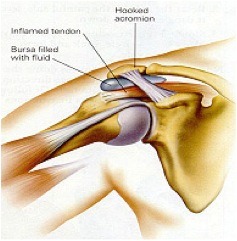What is Shoulder impingement?
Shoulder impingement is a condition in which structures in the shoulder are compressed between your upper arm bone (humerus) and a part of your shoulder blade (acromion). The Shoulder requires stabilization from a variety of muscles to help the shoulder blade maintain optimal movement.
If there are tight structures from something as simple as sitting in bad posture these muscles (example would be pectoralis minor) it can affect how the shoulder blade moves and create an impingement.
Rotator cuff muscles are also important to stop the humeral head from elevating into the acromion. Therefore injury, dysfunction or tightness can lead to poor mechanics and impingement.
Causes of Shoulder impingement
Shoulder impingement is caused by pinching and compression of the rotator cuff tendons and the bursa (fluid-filled sac) between the upper arm bone and the shoulder blade.
If the shoulder blade is not held in a good position (from bad posture) or the rotator cuff muscles are weak, movements of the shoulder can lead to mechanical pinching and inflammation of the soft tissues.
Pain may be located at the upper, front part of the shoulder, although it may extend to the back of the shoulder or even as far as the elbow.
Weakness and/or the inability to lift the arm above the head may also be a problem.
Common Sports presentations It is common in a lot of repetitive overhead arm sports such as baseball, swimming, cricket. It is also a common issue for those in the gym who do a lot of overhead exercises such as military press, snatches, clean and press and bench press
Signs and Symptoms you’re getting shoulder impingement
Pain with overhead movements such as the gym exercises mentioned above Pain when sleeping on the affected side, often worse at night in general.
Hints to help you self manage early on
Rest from the aggravating activities, and avoid repetitive shoulder movements especially overhead
Management Options
You can start with conservative management which would include resting from aggravating factors and physiotherapy to restore range of motion and identify the dysfunctional muscles.
A strength program to work on these weak muscles should be followed.
There is some evidence for corticosteroid injection into the space where the impingement occurs (subacromial space) In severe cases which do not respond to the above options consulting an orthopaedic surgeon may be necessary and surgical decompression and acromioplasty may be advised.
More information
- The scapular stabilising muscles, namely the serratus anterior and the lower and middle trapezius, can often be weak which predisposes the shoulder joint to impingement
- Exercises are often targeted to affect the muscles that control the position of the shoulder blade as well as rotator cuff strengthening
If you are suffering from shoulder impingement why not contact the team at Sydney Physio Solutions to have it checked out.


